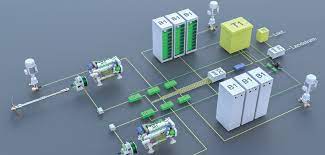Our monitoring and control system partner is Praxis Automation from Leiden in the Netherlands.
Dutch people seem born with two charms attached, bicycles and boats, so when it comes to yacht equipment, they are top of their game in most ways. It was a two-day visit to inspect a simulation of the final scope of delivery and the software package in its preliminary form. After an initial introduction, we got down to business, starting with the drive line.
Explorer Yacht Monitoring & Control System
Our explorer yacht has a duplicated driveline similar to the illustration above; we will look at a single side for now. We have a John Deere 4045 diesel feeding through a clutch into a mechanical step-down drive PHT from Esco Power. This drive connects the hybrid motor to the driveline allowing it to run at higher than engine speed. The drive line then passes to a Twin Disc gearbox before going through a self-aligning coupling and onto the propeller shaft. So far, so good.
Operating modes are as follows:
100% diesel driving the propeller, engaged clutch, gearbox engaged or disengaged
100% electric - diesel clutch disengaged, gearbox engaged
diesel and electric - basically everything running.
Finally, in generating mode charging batteries from the diesel with or without the propeller connected and spinning.
Table 1 shows the various ratio involved, along with some governing performance parameters. Our next task was to run through the various operating modes and consider how they perform with time when loaded, unloaded, or poorly treated. There is no right or wrong here, but it is worth a look. Firstly we checked the various speed limitations.
E-motor | 1500-3600 RPM max | 30kW power - 90kW generation |
Engine | 1000 - 2300 RPM max | 120kW max, clutch to PHT, fixed to E-motor and gearbox. |
PHT | fixed 1.46 (not as thought 1.7) | 250kW max |
Gearbox | 2.5 to 1 step down | 250kW max, F/N/R |
Problem - early documentation for the PHT drive indicated a gear ratio of 1.7:1 or 1.46:1 2300x1.7=3910 >3600 RPM limit on the E-motor, so we have an immediate problem!
Solution - revert to the supplier (Navantec) to verify the "as built" PHT ratio. It is now confirmed at 1.46 - good to go after a brief heart-stopping moment.
Problem - Engine operating at max revs of 2300 RPM, electric motor spinning, unloaded at 2300x1.46=3360RPM
Solution - it checked out, and we are good to go.
Problem - Engine 15% over speed. Engine operating at 2300 RPM, E-motor load removed by de-energizing stator causing over speed.
2300*1.15*1.46=3861 RPM >limit of 3600RPM. Additionally, max high unloaded idle speed can creep up from 2300 to 2350 or 2400 RPM as the Engine Management System only loosely restricts it.
Solution - software limits the maximum engine speed to 2300 RPM. E-motor over speed is mainly an issue of fatigue, so a short duration of over speed acceptable if otherwise uncontrolled.
Problem - Shock load on the drive line. Engine operating at 2300 RPM, E-motor instantly energized, causing shock load on drive line from near-instant 30kW additional load.
Solution - software limit rate of rise of stator excitation over 10-second ramp > response time of engine governor allowing sufficient engine reaction time.
Problem - Overload, engine running at full load driving the propeller, then the E-motor switched to generator mode with the effect of a steeply altered propeller load curve.
Solution - The Energy Management System will parse the load from the drive line to the E-motor in a controlled manner via engine set speed reduction. (With a fixed pitch propeller, the engine set speed controls the maximum load.)
Problem - Accidental propeller rotation. Gearbox in neutral but drag on driveline or propeller in a current.
Solution - oil pressure activated brake on the propeller shaft. As E-motor is permanently rotating with the shaft, add a 3-phase electrical breaker between the stator and Hight Power Inverter for safe future maintenance.
Problem: John Deere Engine controls allow short-term overload to 110%max. Engine software limited to 2300 RPM by Praxis Energy Management System.
Solution - provide manual override, time-limited at 2400RPM for 5 minutes. The owner (us!) will take responsibility for fatigue failure.
Engine controls and one screen of the Energy Management System that interfaces engine, PHT,Gearbox functions.
It is unusual to find both the owner and supplier of marine equipment in the same room simultaneously and without the usual chain of command up and back through the Yard and the Owners Representative. This short line of communication allowed us to step through each identified problem scenario, discuss the implications and draft an action list of preferred solutions during a two-day visit. Apart from 24 aged-body-deforming-hours on a plane, I'd suggest this is a good use of everyone's time late in the project.
Chris Leigh-Jones
My thanks go to Praxis Autionation, especially their excellent staff and our project manager Tobias Andersson. Also, a shout out to our supplier of hybrid PHT drive and steering systems, Okan of Navantec, who managed to send a considered and informative reply within a few hours of our request.
Remember - hybrid drives allow for easy maneuvering and almost full energy independence, they are nota. solution for long voyages on electric only.









